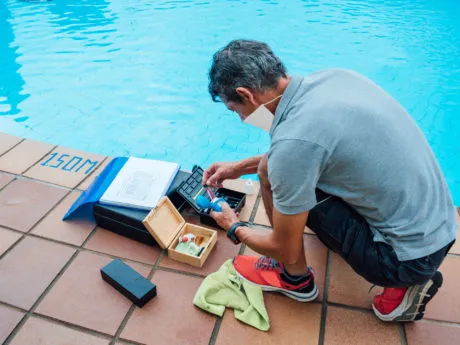Experts' advices
I work in a swimming pool
Chlorinated or brominated products: used mainly to kill bacteria (e.g. calcium, sodium or lithium hypochlorite or chlorinated isocyanurates).


Do not mix or premix these products, be careful to pour them one after another into a large volume of water, such as the pool itself. In case of splashes, a secure protocol must be followed to clean up and neutralize the reactive mixture, in order to avoid any accident complication.
FREQUENTLY ASKED QUESTIONS
This procedure applies in the event of a minor spill that can be managed internally :
- Protect people around you by moving them/evacuating the contaminated area, opening doors and windows if available, and providing adequate personal protective equipment. It is advisable to extinguish any source of ignition in order to not cause accident complications.
- Make a dam around the spill with a neutralizing absorbent, such as TRIVOREX® neutralizing absorbent (for all hazardous liquids) or ACICAPTAL® neutralizing absorbent (specifically for acid spills).
- Sprinkle the absorbent over the spilled liquid. If the residue turns pink it is acid, when it turns back yellow, it is neutral.
- Collect the residue and remove the waste in accordance with the regulations in force.
This procedure applies in the event of a minor spill, i.e. can be managed internally:
- Protect yourself and your employees with breathing apparatus adapted for spilled acid and evacuate all other people. Do not forget that smoke from an acid can irritate the respiratory system.
- Once the spill has been absorbed and neutralized by ACICAPTAL® neutralizing absorbent or TRIVOREX® versatile neutralizing absorbent (also compatible with corrosive acids), the amount of acid vapour will be reduced and the neutralized residue can be picked up more easily.
A corrosive acid spill must be absorbed by a neutralizing absorbent in order to reduce the risks.
When the acid is a concentrated corrosive, the management of the spill may require an additional step for the product to be completely absorbed and neutralized. To do this, sprinkle ACICAPTAL® neutralizing absorbent or TRIVOREX® versatile neutralizing absorbent all around and over the spill. If the liquid is difficult to absorb or the residue is still acid (pink), LeVert chemical decontaminant (or water in its absence) must be poured onto the absorbent to facilitate absorption and neutralization of the acid.
Never mix water directly with a corrosive acid, this may cause an exothermic reaction. We recommend using a neutralizing absorbent to avoid hazardous reactions.
Pool accidents are mostly caused by the involuntary mixing of bleach with an acid. This mixture causes the emission of chlorine gas, dichlor. This toxic gas is extremely irritating. To stop the vapour emission, solidify and neutralize the spill, we recommend the following steps:
- Inform people in the vicinity of the hazard. Then find the right equipment to protect yourself and secure the area.
- Make a dam around the spill with TRIVOREX® versatile neutralizing absorbent (compatible with acids or bases). It will reduce the emission of irritant vapours, neutralize the spill and allow you to pick up the residue more easily.
- Place the neutralizing absorbent on the spill and wait for the pH indicator to turn back yellow, this is when the spill is fully neutralized.
- Collect the neutralized residue and treat it in accordance with the national regulations in force.
Yes, TRIVOREX® versatile neutralizing absorbent (compatible with acids and bases) is capable of:
Reducing toxic vapours by stopping their emission: By neutralizing chemicals that cause vapours, TRIVOREX® versatile neutralizing absorbent makes it possible to stop the emission of vapours at the source of emission.
It is important not to dilute with a bucket of water or a garden hose because contact with water could lead to the release of harmful gases, even to the risk of explosion or fire. The products used are often oxidizing products. We advise you to perform the following procedure:
- Equip yourself with the appropriate equipment and secure the area.
- Make a dam around the spill with a neutralizing absorbent, as for all hazardous liquids. It will significantly reduce gaseous emissions and allow you to pick up residues more easily. Then place the absorbent on the spilled liquid.
- Collect the (neutralized) residues and treat it in accordance with the national regulations in force.